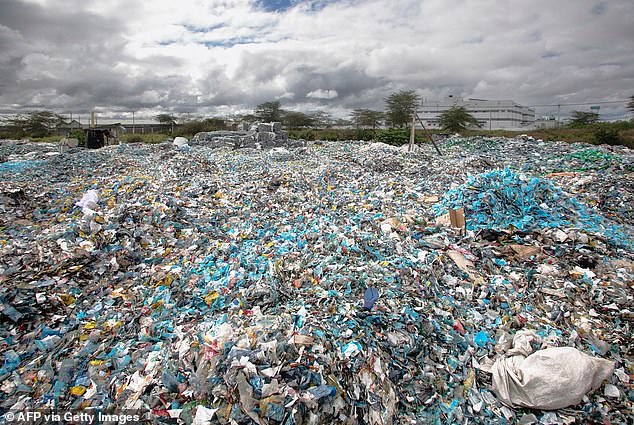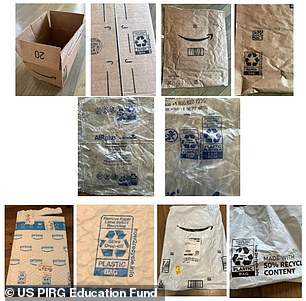More than 700 million pounds of Amazon’s ‘recyclable’ plastic packaging is dumped into the environment every year – where chemicals ravage livestock, human organs and even clouds
It’s the environmental disaster hiding in plain sight: A new report shows that Amazon’s “recyclable” plastic packaging generates 709 million pounds of waste every year.
And almost all that tonnage – which is equivalent in weight to three aircraft carriers – is in danger of disintegrating into increasingly smaller and more dangerous micro- and nanoplastics.
In recent years, scientists have repeatedly made terrifying discoveries about the invisible intrusion of microplastics into all facets of life on Earth, linking it to cancer, cell death, heart disease, Alzheimer’s and Parkinson’s.
The plastic waste created by the e-commerce giant is enough on its own to circle the Earth more than 800 times, a figure that doesn’t include Amazon’s many millions of tons of cardboard and Amazon’s non-recyclable plastic packaging .
Making matters worse, the new report shows that Amazon’s so-called “recyclable” plastics require customers to take their waste packaging to special “retail drop-off points where plastic film is accepted.”
Given customer expectations of Amazon’s door-to-door convenience, less than five percent of that plastic, the new research shows, ever ends up in a recycling center.
The new report from the US Public Interest Research Group finds that much of Amazon’s so-called ‘recyclable’ plastic requires customers to take their waste packaging to special ‘retail drop-off points where plastic wrap is accepted’

Their report shows that as of 2021, Amazon’s “recyclable” plastic packaging will generate 709 million pounds of waste each year — a tonnage equivalent in weight to that of 3,000 adult blue whales.
“We conducted a study on the effectiveness of the store drop-off system that Amazon uses to recycle their plastic film packaging,” says Jenn Engstrom, author of the new report and director of the California chapter of the US Public Interest Research Group (PIRG), explained.
“(PIRG) employees and volunteers placed small tracking devices, primarily Apple AirTags, into 93 bundles of Amazon plastic bags, bubble-lined plastic bags, and air cushions, and placed them in trash bins across the country to see where they ended up.”
Even for this packaging delivered to one of Amazon’s designated delivery points, including Target stores, only four of the 93 plastics reached a recycling center.
“We found no evidence that Amazon packaging is widely recycled,” said Engstrom and her co-author Celeste Meiffren-Swango of Environment Oregon concluded.
Even with those four items they said: ‘You cannot know whether the packaging has subsequently been sorted for recycling or not.’

Nearly 9 percent went straight to landfills and 3 percent went to overseas ports, while the rest of this plastic packaging went into incinerators, back to Amazon warehouses and distribution centers, or to parts unknown, according to US PIRG.
The largest traceable percentage, roughly a quarter (24 out of 93), went to Trex: a company that mixes some plastic film with sawdust to make plastic decks.
But, as Engstrom said Los Angeles TimesIt is uncertain how much use Trex actually makes of that plastic.
The company’s guidelines have a strict policy on the plastic film it accepts, stating that it must be ‘free from food or liquid contamination (and) that labels should be removed where possible.’
Nearly nine percent of the plastic examined in the Amazon drop-off went straight to landfills.
Three percent went to ports bound for overseas, and the rest of the 93 recyclable plastic packages delivered went to incinerators, back to Amazon warehouses and distribution centers, or to parts unknown.

The wide variety of non-recyclable plastics – including those from Amazon above – are labeled with small, numbered “recycling” logos that have made it more difficult for state and local programs to actually recycle recyclable plastics – which are labeled with the numbers ‘1’ and ‘2’
With estimated annual revenue last year of more than $574 billion, Amazon is a major contributor to the global plastic waste problem, but as PIRG and the nonprofit ocean conservation organization Oceana point out, Amazon is just one of many e-commerce shippers.
PIRG and Oceana estimate that global e-commerce generated as much as 3.4 billion pounds of plastic packaging waste in 2021 alone.
Engstrom said industry experts and environmental groups expect those numbers to double by 2026 — despite companies like Amazon labeling their packaging as recyclable.
“These companies know that consumers are confused by the recyclable labels,” Jan Dell, a former member of California’s Statewide Commission on Recycling Markets and Curbside Recycling, told the LA Times.
Dell noted that the wide variety of non-recyclable plastics with small, numbered “recycling” logos has made it more difficult for state and local governments to identify actually recyclable plastics, which are labeled with the numbers “1” and “2.” , to recycle.
The thin plastic film from Amazon’s bubble wrap, bubble wrap and other packaging can wreak havoc on a recycling center’s daily operations, blocking machines, destroying expensive equipment and sometimes injuring workers.
This lighter plastic can also be sorted with paper waste due to its similar thin sheet-like consistency, which contaminates recycled paper and sometimes makes it unsellable.
“They are destroying curbside recycling with costly and dangerous contamination,” said Dell, who is now director of the Orange County group Last Beach Cleanup.
Three years ago, Dell partnered with Bloomberg investigates the fate of Amazon’s plastic bags: “They went to the landfill, were burned and exported,” she said.
Despite the persistence of the problem, an Amazon spokesperson, Katie Larsen, said in a statement that the tech giant is “continually reducing packaging waste and working to make recycling easier for customers.”
Larsen added that the U.S. PIRG did not monitor how Amazon’s delivery locations handled the company’s plastic. ‘We no longer have control over how packaging is handled after it has been thrown away by councils or recycling centres.’
Amazon, she said, has “launched a multi-year effort to transition U.S. fulfillment centers from plastic to paper for our delivery packaging.”
